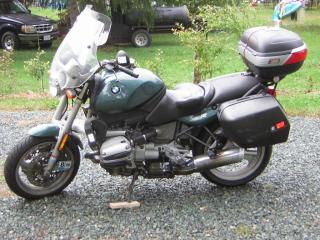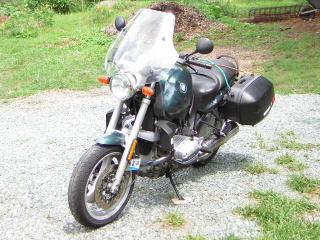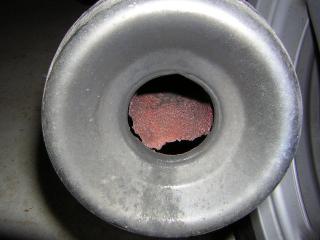
After two years on the R850R it is time for an in-depth review. Even though this bike is more than 15 years old, it shares many qualities with newer "oilhead" R BMW motorcycles, and I'll allude to both the similarities and differences.
In this photo notice that I've added a 50 liter Givi top case. I love it. Notice that the windscreen is fairly steep, and that there is no fairing. More on this later.
Overall this is a wonderful bike. It has a long list of features I want in my daily ride, and only a small list of niggles. Since modern bikes are largely very reliable, I'll separate out the mechanical issues from the day-to-day qualties. The features are: quiet exhaust, comfy seat, good ergonomics, windscreen, locking hard luggage, clock, low fuel warning light, tachometer, center stand, cylinder head guards, great handling (cornering and braking), reasonable power, moderate clutch effort, 12 volt power outlet, luggage/fuel/helmet locks all keyed to the ignition key, running lights (i.e. yellow marker lights), hazard flashers, a decent tool kit, and shaft drive. The mirrors are set just wide enough. I recently added a Kisan Signal Minder which I love.
The cylinder heads sticking out is not a problem. The handlebars and mirrors are wider (so are those wide touring cases). No, the heads don't drag on the ground when leaned over cornering. That is only an issue when knee-down at the race track, and not much of an issue there.

Notice that the turn/marker lights are mounted in-board of what will hit the ground if the bike tips over. The bike mostly rests on the cylinder head guards and the luggage. This is good since parking lot drops happen. The cylinder head guards are black plastic "frames" on the lower part of the head. The guards are kind of hard to see in these photos.
The seat is a Russell Day-Long saddle and is very comfortable. The luggage, windscreen, clock and tack are all extra options. My bike has the low-mount exhaust which I'm guessing was a zero-cost factory option. Nearly all the BMW R bikes come standard with the centerstand.
Features I wish for are a fuel gauge, self canceling turn signals, full engine gauges (oil pressure, temperature), better aerodynamics, less weight, less engine vibration, less clunky transmission, more power, and an underseat exhaust.
Mechanically this bike is fairly advanced. It has fuel injection, electronic spark control, dual front disk brakes, (with dual 4 piston calipers), rear disk brake, BMW's Telelever front suspension which is inherently anti-dive, BMW's Paralever shaft drive rear which has an extra pivot to overcome shaft effects, four valve cylinder heads, a large alternator, catalytic converter (to lower emissions), adjustable pre-load on the rear shock, steering damper, alloy wheels with sport-touring tires.
This bike is a great package. It starts easy no matter how cold the weather, pulls hard from about 2000 rpm, shifts reasonably well (more on that later), has great brakes, and corners very well. I find the steering to be fairly light, responsive, stable, and allows me to either hold a line or change a line mid-corner. I counter-steer and often shift weight on the footpegs, so I have reasonably good habits. Nonetheless, for a bike of this weight and suspension geometry, the R850R does great at dodging potholes or carving the twisty Virginia backroads. Of course, on the expressway the bike is very stable.
Now we come to the issues of this motorcycle.
The horizontally opposed oil and air cooled twin cylinder engine is great, but somewhat buzzy at highway speeds. It pulls well from 2000 rpm, which means that in-town commuting is a breeze. It has a distinct surge about 4000 rpm and will happily pull out to 6000 (redline is 7500). I'm guessing that this bike does 0-60 mph in about 4.5 seconds. Not nearly as fast as a 90 horsepower bike like the Honda VFR750F, but far, far faster than all but the fastest cars. Also the 60-to-80 roll on is great. Passing on the freeway is no problem. The engine has a nice burble around town. The valve drive makes a quiet "swishing" sound, unlike some engines that have a turbine note (and I'm talking about actual engine sound, not the exhaust note).
The Paralever rear suspension is nice. Modern BMW shaft drives go at least 60,000 miles without between services. I think the newest drives are called "lifetime", whatever that means. The Paralever works great. The extra pivot at the rear helps the bike respond to throttle changes more like a chain drive. Adding throttle to a chain drive bike makes the rear stand up, and this is part of the reason we are told to roll-on the throttle when exiting turns. Non-Paralevel shaft drives are prone to shaft effect. I'm not clear about this, but it is some kind of disconcerting movement in the rear end if you change throttle in mid-turn. The BMW suspension is stable, predictable, and corners really well.
The engine is good. It is reliable, has a great torgue curve, is mounted low on the bike to keep the center of gravity low. The engine is mechanically reasonably quiet, without much extraneous noise. Many motorcycle engines have a lot of noise from the cam chain or gears. The BMW engine has a little bit of clicking, and a kind of sussuration which I assume is the cam chain. The engine doesn't use a drop of oil. It does have an odd (occasional) trait. Once in a while, if I park on the side stand, the exhaust will emit a puff of white smoke when I start the engine. This doesn't happen when the bike is parked on the center stand (which is most of the time), so I'm gussing it is some weird trait of oil sneaking past the rings on the "downhill" (left) cylinder.
The niggles with this bike start with the engine. Unless the two throttle bodies are perfectly synchronized the bike is buzzy at highway speeds. The footpegs have rubber coverings, and the handgrips are on rubber mounts. BMW knew this bike was buzzy and tried to compensate. They were largely successful. The throttle cable linkage between the throttle bodies changed around 1996, and this makes it easier to keep the throttle bodies synchronized. It is typical for BMW R bikes to buzz at highway speeds. I've talked to several owners who confirm that their mirrors are pretty much useless at 65 mph. Highway rpms are around 4000. The vibration seems to vary a bit with temperature changes. In any case, the buzz isn't terrible.
The most recent R1200 bikes have a counter-shaft which is rumored to get engine vibration to almost nothing (except the HP which doesn't have a counter shaft in order to save weight).
On some mid-to-late 1990's oilhead R bikes, surging from the fuel injection was reported to be a problem. I can sometimes detect a tiny surge at about 30 mph under no load. This is just barely off-idle and feels like a flat spot in the acceleration. However, it isn't "flat" and a twist of the throttle gives an instant strong response.
The R850R (and R1100R) have an add-on syle of windshield instead of a real fairing. This saves weight, but the air spilling off the top of the windscreen is somewhat turbulent. Adding a Laminar Lip helped. I'm 5 foot 8 inches. Taller or shorter riders would probably have a different experience.
Now we come to the transmission. The good news is that it works, and apparently lasts a long, long time. The first two things you'll notice is that getting into gear from neutral is "interesting". This is minor and easily dealt with. Due to the dry clutch, the transmission has zero load when the clutch is in, as opposed to wet clutches which are always trying to spin the transmission, even when the clutch is disengaged. Here's the solution, and you have to do these steps in order:
1) In neutral, bike running, clutch out. Slightly depress the shift lever until you feel a little resistance.
2) Pull in the clutch, and just as you get it in, finish depressing the shift lever. You'll drop into first gear with a satisfying little "snick".
There must be less than 1 second between pulling in the clutch and depressing the shifter.
The next thing you'll notice is that neutral is hard to find. There really isn't much of a stop or detent for neutral, and the neutral light is finicky. From first gear, stopped, with the clutch disengaged (lever in), give the shift lever a light upward tap. Slowly release the clutch; the neutral light may or may not immediately light. With a little practice (3 or 4 times) this should be pretty easy.
The big issue with the transmission is downshifting to second and first gears. The tranny makes a loud clunk. It helps to downshift at relatively low speeds (under 10 mph), but there is no way to get around the clunk. I recently changed over to the BMW recommended 75W-140 synthetic gear oil. It made a very small improvement. Upshifts are fine in all gears, and downshifting to fourth and third is fine. Everyone says that the transmissions are strong and will outlast the rest of the bike.
Newer BMW bikes have improved transmissions. BMW fixed both the problem of getting into first gear, and the clunking downshifts.
More power would be nice. The R850R only puts out about 65 horsepower. For comparison, at 90 or 100 horsepower a bike starts to feel really fast. The nice thing is that the BMW R bikes have a great torque curve, therefore essentially all that power is on tap at low rpms. Race bikes don't start pulling well until about 7000 rpm. The more usable power of the BMW compensates (somewhat) for the lower power.
In the US, BMW only imported the R850R in 1995 and 1996. Therefore, nearly all the Roadsters here are R110R bikes, which are more like 80 or 90 horsepower.
The R bikes all need premium unleaded. They'll run on lower octane, (some GS models have an electronic octane adjustment), but you start to get fuel knock and risk burning the valves. For comparison, my 1995 Honda VFR750F ran 87 octane fuel in spite of the high compression ratio and 90 horsepower output from an engine 100cc smaller than the R850R.
A mechanical argument in favor of the oilhead R engines is simplicity. Oil cooling saves weight and complexity. No water jacket, no water pump, etc. The R bikes have oil coolers (like radiators), but they can't freeze. I think BMW goes so far as to spray oil on the bottoms of the pistons to keep them cool. This is high-tech stuff, but mechanically fairly simple.
Less weight would be nice, and BMW has been trying to trim the fat on newer models. Apparently the R1200S is quite a bit lighter than the R1100S. I'm guessing that my R850R is around 550 pounds, wet. That's not terrible, and even sport bikes come in at around 450 wet.
I had a couple of serious things go wrong. Apparently I had bad luck. One of the Hall-effect sensors went bad (there are two sensors on the crank position assembly). This is the crank position sensor that fires the ignition. I think that was a 180 dollar part. These should last 100,000 miles, but mine only made it 23,000.
I also had a small connector in the fuel-pump-fuel-sender assembly go bad. It was very hard to diagnose because it only failed intermittently (stranding me each time), and I mistakenly replaced the fuel pump first (nearly 200 US dollars). That didn't fix the problem, and the bike stranded me a couple more times around town. I finally was able to diagnose a bad connection. The fuel sender was nearly 200 USD (for comparison, the fuel sender in my 1973 VW Bug was 15 USD). That fixed the problem, and afterward I spent another couple of hours working on the bad fuel sender assembly tracking down the exact location of the failed connector. I'm calling it a manufacturing defect. The good news is that even with such a defect, the part lasted for 15 years.
Due to not changing the brake fluid often enough (blame the previous owner), the front master cylinder got clogged. The fix was easy, and cost was only a 45 dollar rebuild kit.
 After two years on the R850R it is time for an in-depth review. Even though this bike is more than 15 years old, it shares many qualities with newer "oilhead" R BMW motorcycles, and I'll allude to both the similarities and differences.
After two years on the R850R it is time for an in-depth review. Even though this bike is more than 15 years old, it shares many qualities with newer "oilhead" R BMW motorcycles, and I'll allude to both the similarities and differences.
